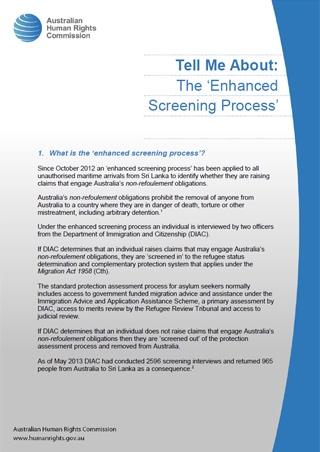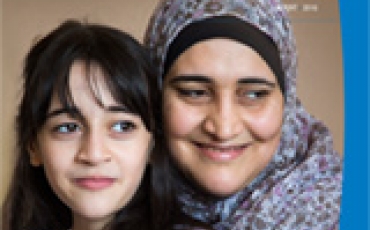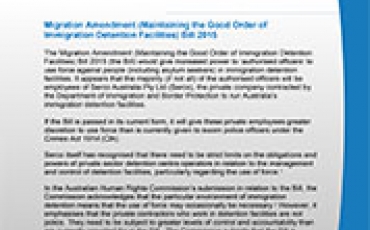Tell Me About: The ‘Enhanced Screening Process’

1. What is the ‘enhanced screening process’?
Since October 2012 an ‘enhanced screening process’ has been applied to all unauthorised maritime arrivals from Sri Lanka to identify whether they are raising claims that engage Australia’s non-refoulement obligations.
Australia’s non-refoulement obligations prohibit the removal of anyone from Australia to a country where they are in danger of death, torture or other mistreatment, including arbitrary detention.[1]
Under the enhanced screening process an individual is interviewed by two officers from the Department of Immigration and Citizenship (DIAC).
If DIAC determines that an individual raises claims that may engage Australia’s non-refoulement obligations, they are ‘screened in’ to the refugee status determination and complementary protection system that applies under the Migration Act 1958 (Cth).
The standard protection assessment process for asylum seekers normally includes access to government funded migration advice and assistance under the Immigration Advice and Application Assistance Scheme, a primary assessment by DIAC, access to merits review by the Refugee Review Tribunal and access to judicial review.
If DIAC determines that an individual does not raise claims that engage Australia’s non-refoulement obligations then they are ‘screened out’ of the protection assessment process and removed from Australia.
As of May 2013 DIAC had conducted 2596 screening interviews and returned 965 people from Australia to Sri Lanka as a consequence.[2]
2. What are the Commission’s concerns?
The Commission is concerned that the enhanced screening process may not protect people from refoulement in accordance with Australia’s obligations under the International Covenant on Civil and Political Rights, the Convention on the Rights of the Child, the Convention Against Torture and the Refugee Convention.[3]
Australia’s non-refoulement obligations prohibit the removal of anyone from Australia to a country where they are in danger of death, torture or other mistreatment, including arbitrary detention. The principle of non-refoulement requires Australia to provide asylum seekers with effective access to fair and efficient asylum procedures.
The Commission is concerned that the enhanced screening process is not a fair asylum procedure and risks excluding those with legitimate claims for protection. The Commission’s key concerns include the following:
- people subjected to the screening process are not informed of their right to seek asylum
- screening interviews may be brief and not sufficiently detailed or probing to ensure that all relevant protection claims are raised. Some asylum seekers may not be able to raise or adequately express their needs for protection in a brief interview shortly after their arrival in Australia, especially in the absence of legal advice about their right to seek asylum.
- the ‘screening’ process may in fact be used not for screening but for substantive assessment of claims, and that people might be screened out where DIAC is of the view that their claims are remote, unfounded or insufficient.
- persons subject to the screening process may not be informed of their right to seek legal advice and are only provided with reasonable facilities to contact a legal adviser if they make a specific request
- persons subject to the screening process may not be provided with an adequate opportunity to respond to adverse information
- persons who are ‘screened out’ are not given a written record of the reasons for the decision, nor do they have access to independent review of such decisions.
The Commission is particularly concerned that unaccompanied minors who arrive unauthorised by boat from Sri Lanka are subject to the enhanced screening process and may not have adequate support. For example, unaccompanied minors are not informed of their right to seek asylum and have no access to independent legal advice unless they specifically request it.
3. What does the Commission recommend?
The Commission recommends that all asylum seekers arriving by boat, including those arriving from Sri Lanka, should be provided with the following:
- Information regarding their right to seek asylum
- Information regarding their right to seek legal assistance
- Contact details for Legal Aid and community legal centres
- Contact details for independent monitoring bodies including the Australian Human Rights Commission, the Commonwealth Ombudsman and the United Nations High Commissioner for Refugees
- Access to interpreters, communication facilities and interview rooms to allow them to make effective and private contact with independent monitoring bodies and/or legal advisers, as well as, information about their ability to access these facilities.
Further, the Commission recommends that the ‘enhanced screening process’ be discontinued. Where protection claims are raised, all asylum seekers should be ‘screened in’ and should have their claims fully assessed under the refugee status determination and complementary protection system that applies under the Migration Act, with access to legal or migration advice and assistance, independent merits review and judicial review.
[1] See for example, United Nations High Commissioner for Refugees, Advisory Opinion on the Extraterritorial Application of Non-Refoulement Obligations under the 1951 Convention relating to the Status of Refugees and its 1967 Protocol (26 January 2007), para 6. At http://www.unhcr.org/cgi-bin/texis/vtx/refworld/rwmain?docid=45f17a1a4&page=search (viewed 25 March 2013). In relation to the operation of the ICCPR in this regard, see the decisions of the Human Rights Committee referred to in note 25 above. In relation to the operation of the CRC in this regard, see Committee on the Rights of the Child, General Comment No 6 - Treatment of unaccompanied and separated children outside their country of origin, UN Doc CRC/GC/2006/6 (2005), para 27. At https://www.ohchr.org/EN/ProfessionalInterest/Pages/CoreInstruments.aspx (viewed 25 March 2013).
[2] Evidence to Senate Legal and Constitutional Affairs Legislation Committee - Budget Estimates, Canberra, 28 May 2013, p 36 (Alison Larkins, First Assistant Secretary, Refugee, Humanitarian and International Policy Division, Department of Immigration and Citizenship).
[3] International Covenant on Civil and Political Rights, opened for signature 16 December 1966, 999 UNTS 171 (entered into force 23 March 1976) (ICCPR). At https://www.ohchr.org/EN/ProfessionalInterest/Pages/CoreInstruments.aspx (viewed 25 March 2013); International Covenant on Economic, Social and Cultural Rights, opened for signature 16 December 1966, 993 UNTS 3 (entered into force 3 January 1976) (ICESCR). At https://www.ohchr.org/EN/ProfessionalInterest/Pages/CoreInstruments.aspx (viewed 25 March 2013); Convention on the Rights of the Child, opened for signature 20 November 1989, 1577 UNTS 3 (entered into force 2 September 1990) (CRC). At https://www.ohchr.org/EN/ProfessionalInterest/Pages/CoreInstruments.aspx (viewed 25 March 2013); Convention against Torture and Other Cruel, Inhuman or Degrading Treatment or Punishment, opened for signature 10 December 1984, 1465 UNTS 85 (entered into force 26 June 1987) (CAT). At https://www.ohchr.org/EN/ProfessionalInterest/Pages/CoreInstruments.aspx (viewed 25 March 2013); Convention Relating to the Status of Refugees, opened for signature 28 July 1951, 189 UNTS 137 (entered into force 22 April 1954), as amended by the Protocol Relating to the Status of Refugees, opened for signature 31 January 1967, 606 UNTS 267 (entered into force 4 October 1967) (Refugee Convention). At http://www.unhcr.org/3b66c2aa10.html (viewed 25 March 2013).


